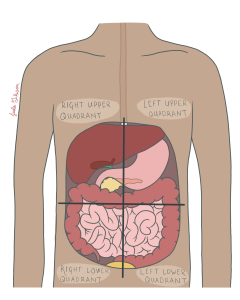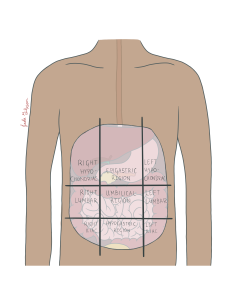3 Abdominal Sections
Abdominal Sections:
Imagine you’re plotting out your next great adventure through a massive city. You could draw a 3×3 grid over your map, dividing it into nine distinct zones like a tic-tac-toe board. Or, if you’re feeling a bit less ambitious, slap on a 2×2 grid and voilà—you’ve got four manageable chunks. This nifty trick helps you break down the sprawling metropolis into bite-sized areas for easier exploration.
Now, think of anatomists doing something similar, but with the human body. They use quadrants and/or regions to pinpoint different organs.
View the following images to get better acquainted with each sectioning plane. Understanding each format can help foster an understanding of mapping structures on the fly!
 |
 |
Figure 3 Anatomical quadrants(left) and anatomical regions(right)
View the right diagram of Figure 3. It can be divided into these segments:
Table 4 The 9 anatomical regions
| Region | Contents: |
| Right hypochondriac region | Right lobe of the liver, gallbladder, part of the kidney and small intensive |
| Epigastric region | Stomach, left lobe of the liver, pancreas, duodenum, part of the spleen |
| Left hypochondriac region | Part of the stomach, spleen, part of the pancreas, part of the left kidney, part of the large intestine |
| Right lumbar region | Part of the ascending colon, part of the small intestine, part of the right kidney |
| Umbilical region | Majority of the small intestine, part of the duodenum, part of the transverse colon |
| Left lumbar region | Part of the descending colon, part of the left kidney, part of the small intestine |
| Right iliac/inguinal region | Cecum, appendix, part of the small intestine |
| Hypogastric region | Bladder, part of the small intestine, sigmoid colon, uterus |
| Left iliac region | Part of the descending colon, sigmoid colon, part of the small intestine |

